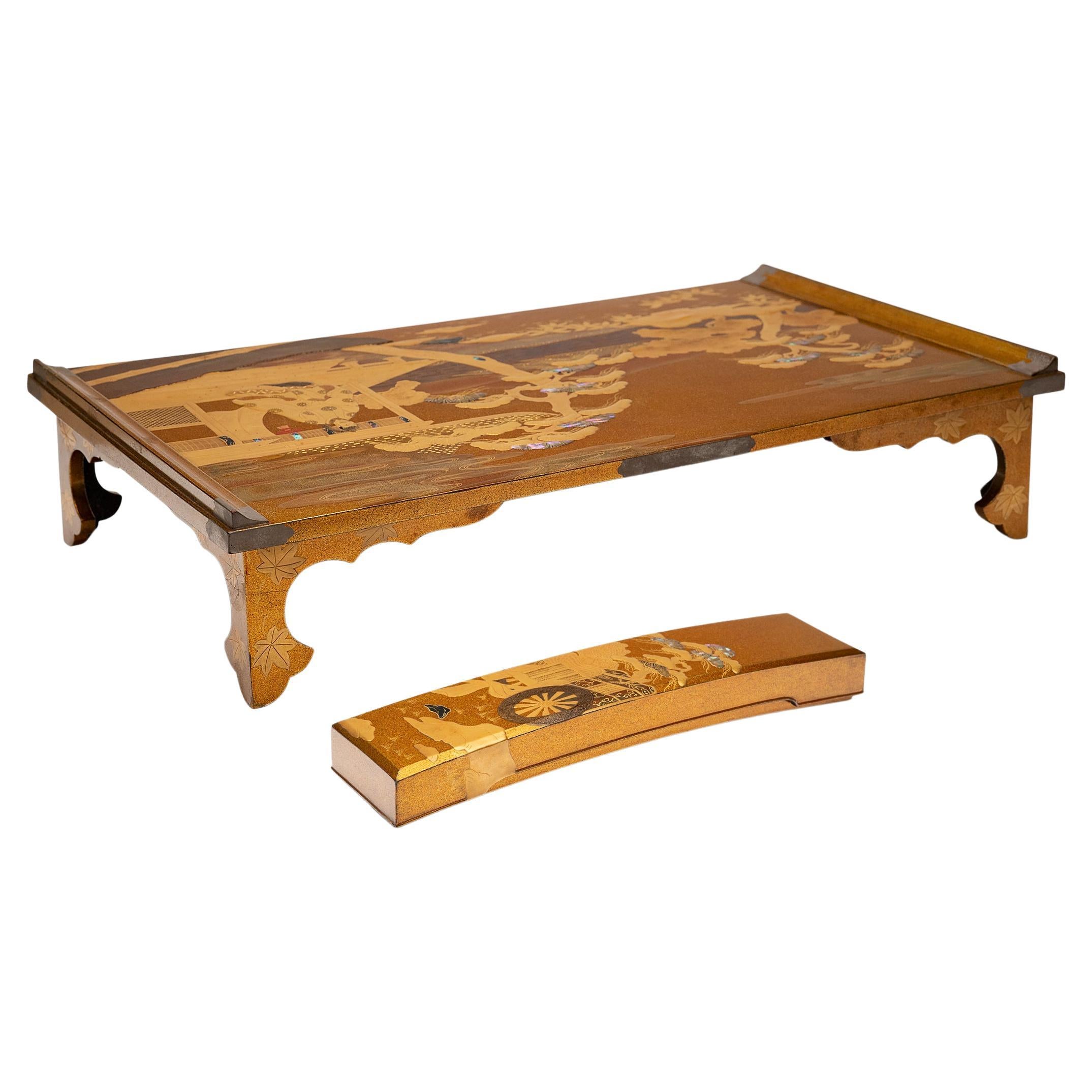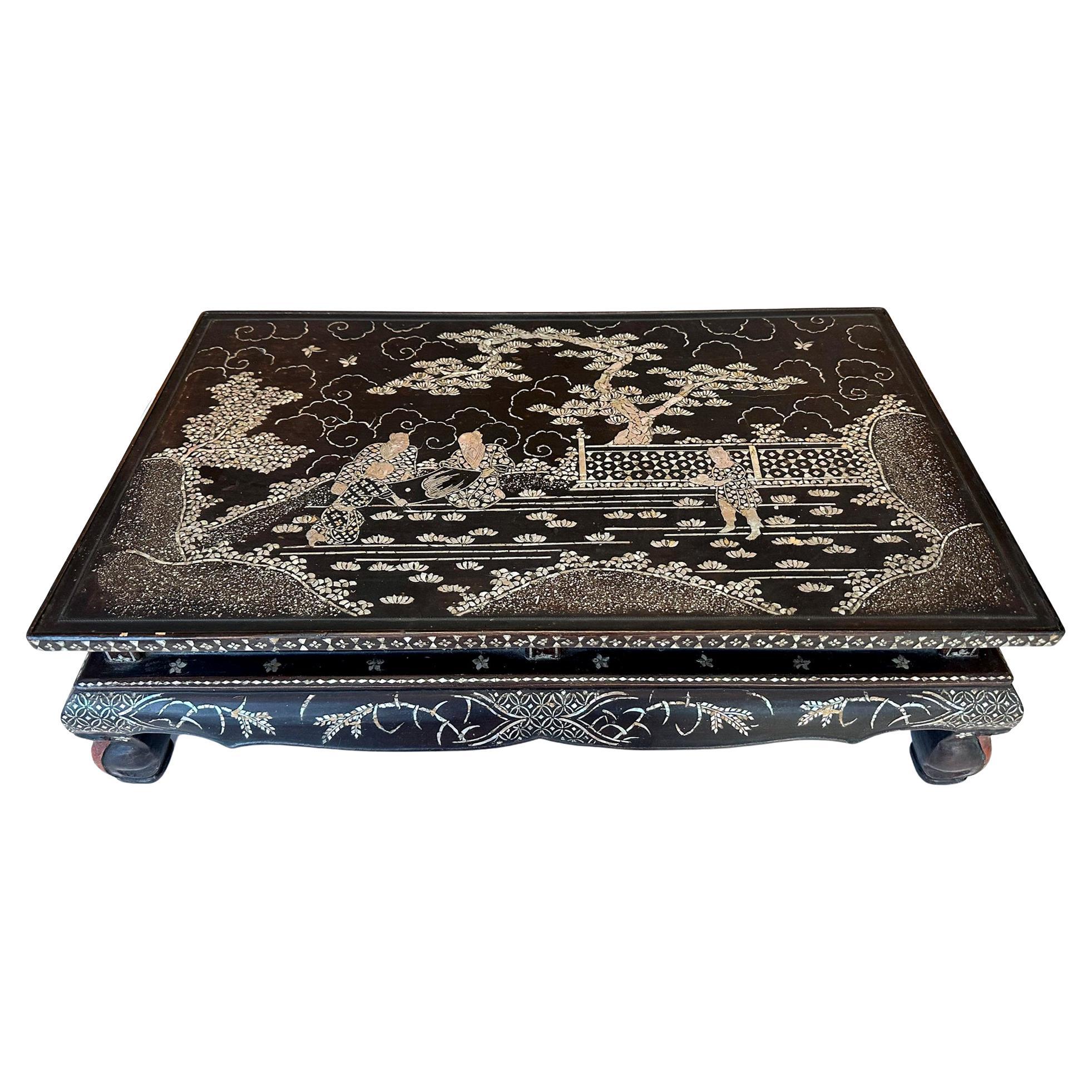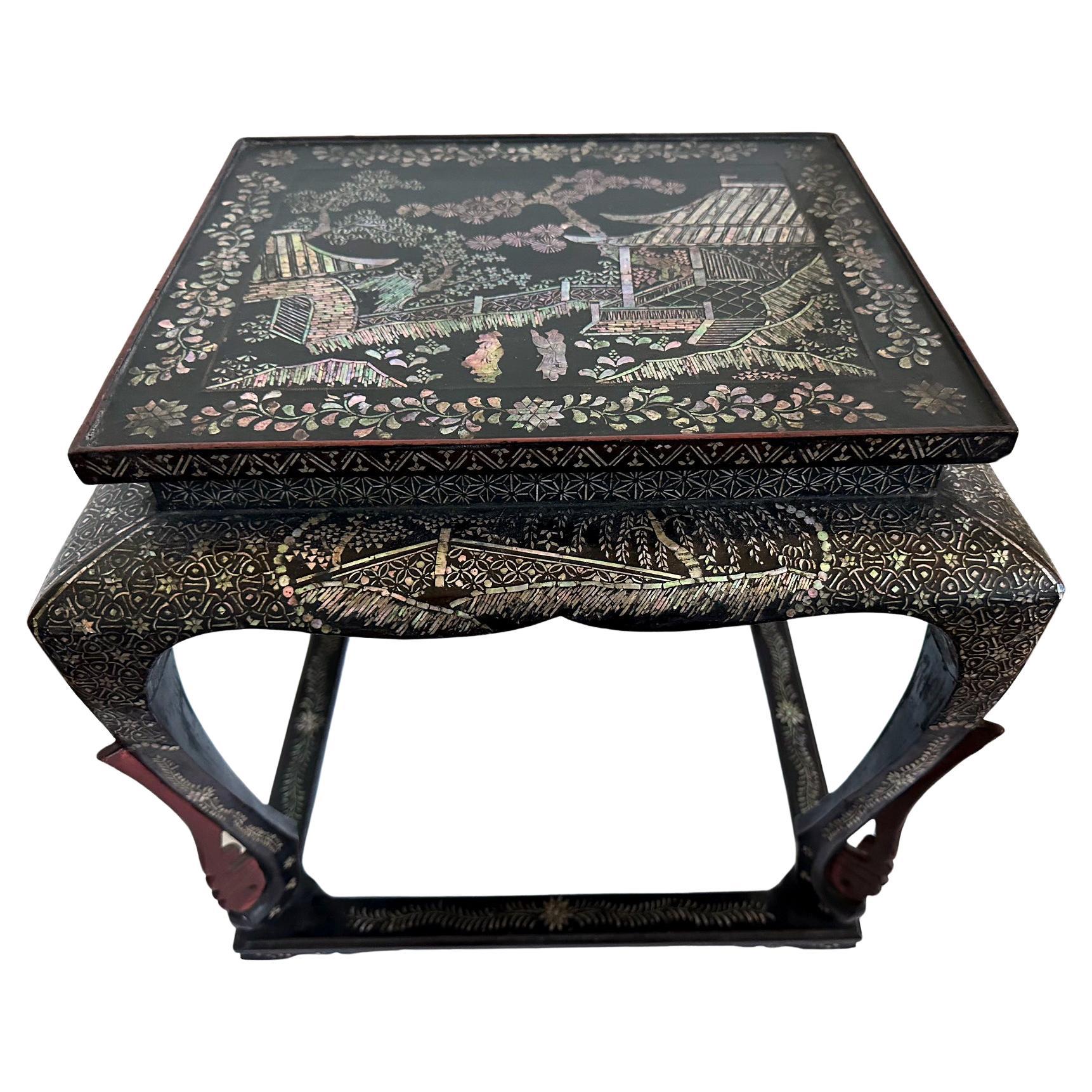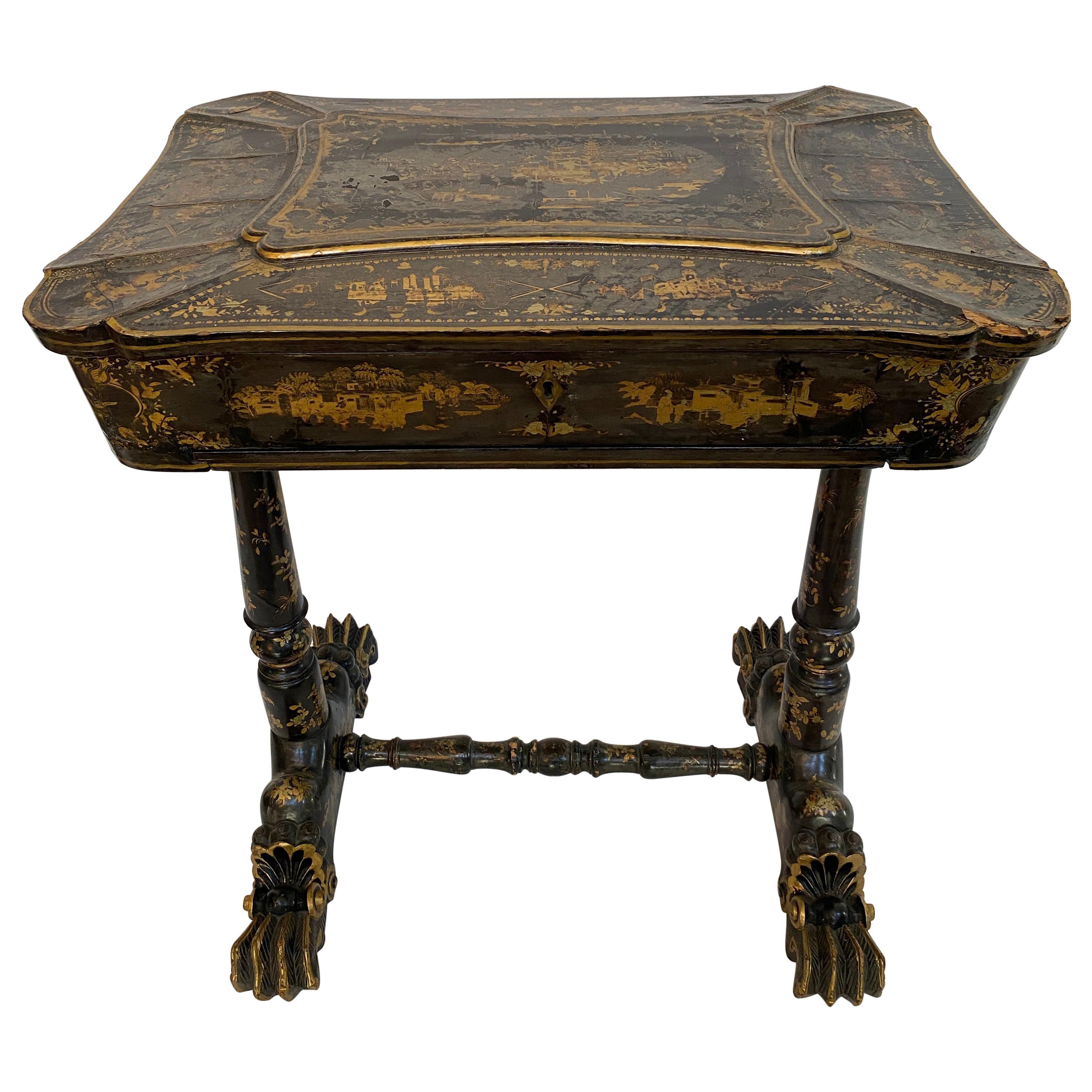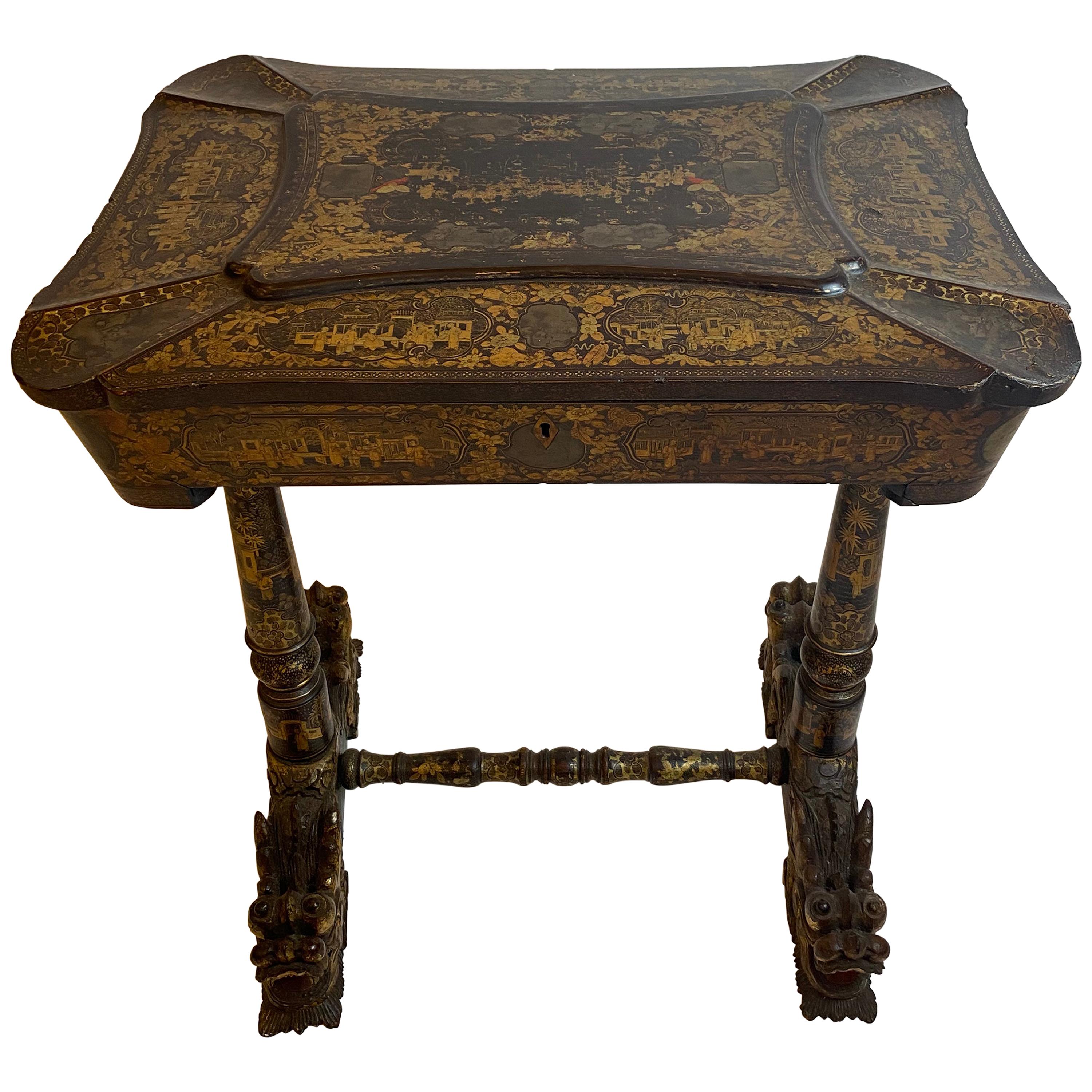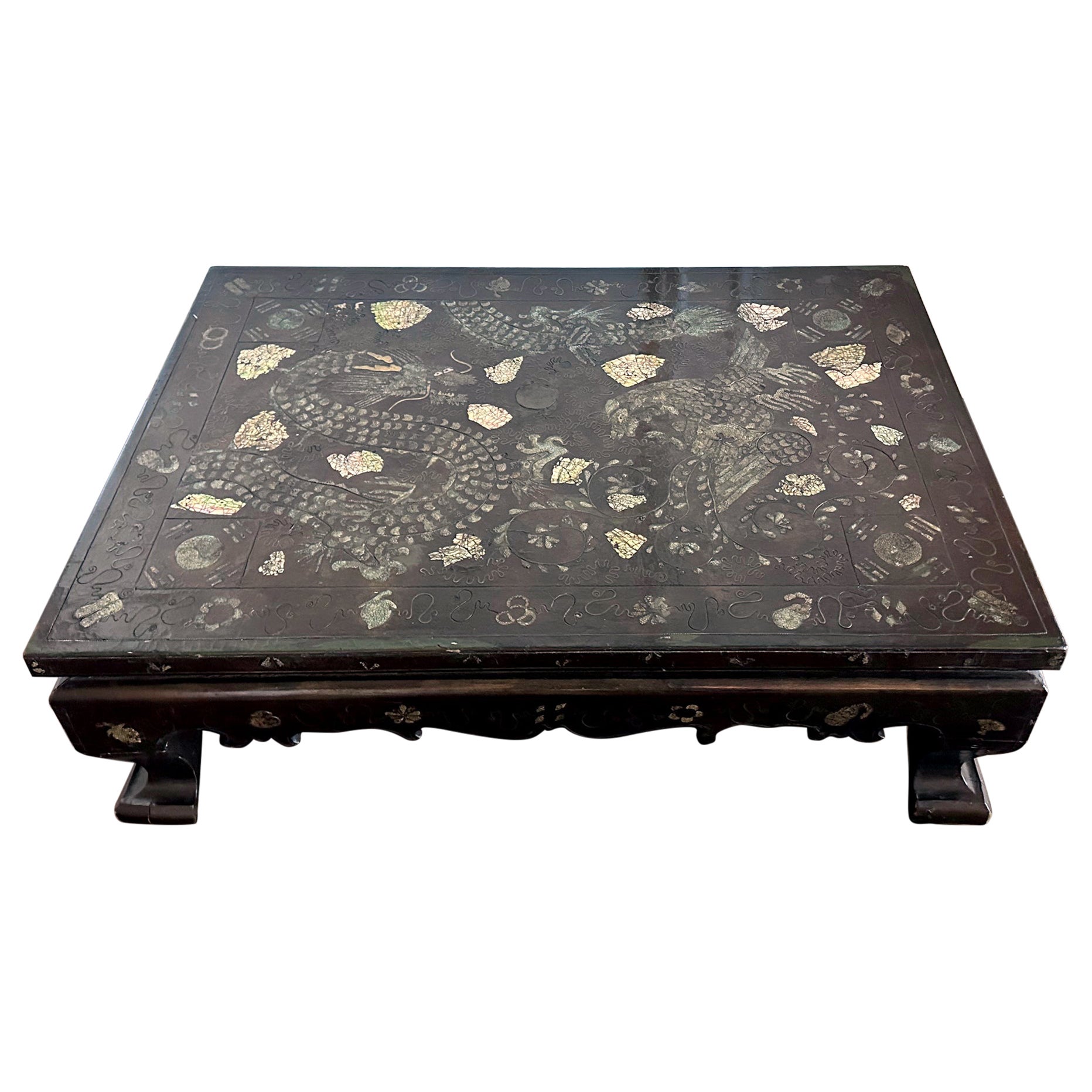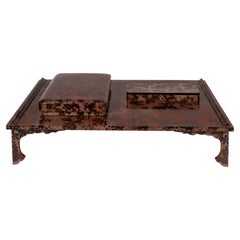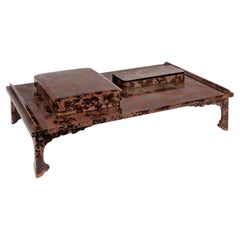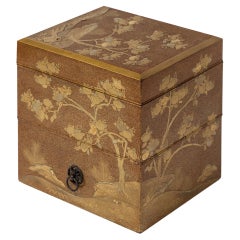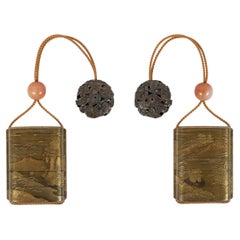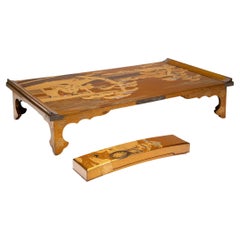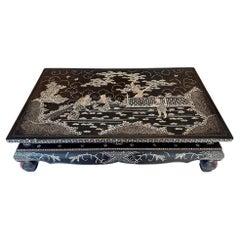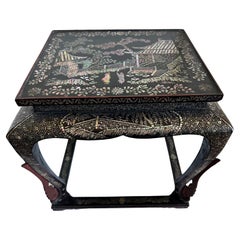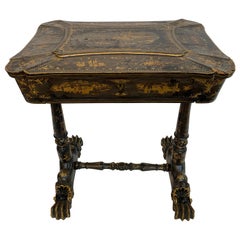Items Similar to Japanese Bundai or writting table in gold lacquer with a decor of lake landscape
Want more images or videos?
Request additional images or videos from the seller
1 of 10
Japanese Bundai or writting table in gold lacquer with a decor of lake landscape
$17,987.68
£13,381.02
€15,000
CA$24,631.29
A$27,386.64
CHF 14,299.79
MX$333,362.14
NOK 182,459.15
SEK 170,955.50
DKK 114,186.72
Shipping
Retrieving quote...The 1stDibs Promise:
Authenticity Guarantee,
Money-Back Guarantee,
24-Hour Cancellation
About the Item
Rectangular bundai writing table on four legs in gold lacquer with black highlights on a nashi-ji background. The top is decorated with a lake landscape with plum trees, pine trees and the clover-shaped coat of arms mon (maru ni katabami) of one of the clans descended from the Matsudaira family in takamaki-e and kirigane lacquer and silver inlays.
Silvered bronze mounting.
Japan – Edo period (1612-1868)
Height : 4.5 in / 11.5 cm – length : 22.8 in / 58 cm – depth : 13.4 in / 34 cm
- Dimensions:Height: 4.53 in (11.5 cm)Width: 13.39 in (34 cm)Depth: 22.84 in (58 cm)
- Style:Edo (Of the Period)
- Materials and Techniques:
- Place of Origin:
- Period:
- Date of Manufacture:1603-1868
- Condition:Wear consistent with age and use.
- Seller Location:PARIS, FR
- Reference Number:Seller: 2023-11281stDibs: LU8311242791712
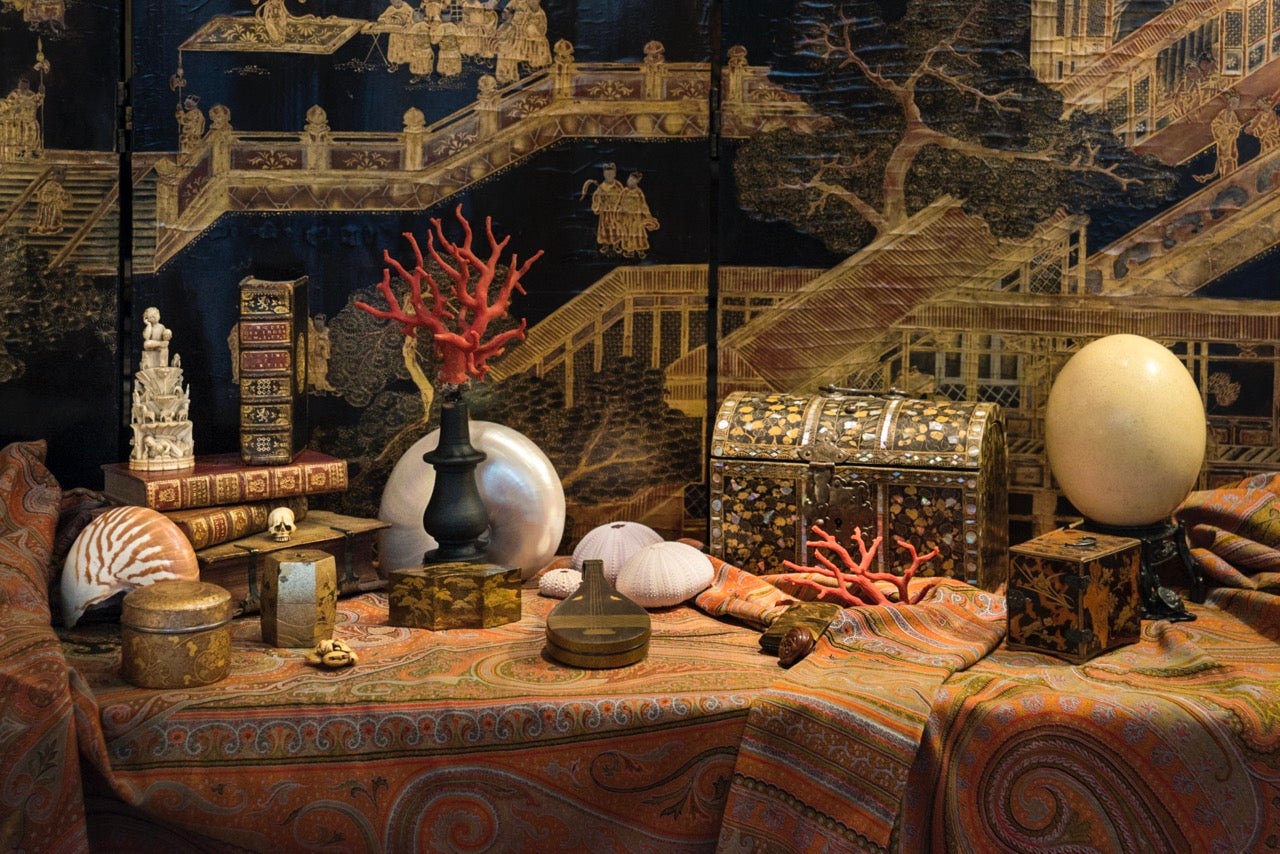
About the Seller
No Reviews Yet
Vetted Professional Seller
Every seller passes strict standards for authenticity and reliability
Established in 2013
1stDibs seller since 2023
Typical response time: Several days
- ShippingRetrieving quote...Shipping from: PARIS, France
- Return Policy
Authenticity Guarantee
In the unlikely event there’s an issue with an item’s authenticity, contact us within 1 year for a full refund. DetailsMoney-Back Guarantee
If your item is not as described, is damaged in transit, or does not arrive, contact us within 7 days for a full refund. Details24-Hour Cancellation
You have a 24-hour grace period in which to reconsider your purchase, with no questions asked.Vetted Professional Sellers
Our world-class sellers must adhere to strict standards for service and quality, maintaining the integrity of our listings.Price-Match Guarantee
If you find that a seller listed the same item for a lower price elsewhere, we’ll match it.Trusted Global Delivery
Our best-in-class carrier network provides specialized shipping options worldwide, including custom delivery.More From This Seller
View AllJapanese writting set in waqasa lacquer including bundai ryoshibako and fudebako
Located in PARIS, FR
Set of bundai, ryōshibako and fudebako in wakasa lacquer with an old rose background and black traditional Japanese patterns.
The saya pattern (or sayagata) is composed by Chinese svastikas. This symbol linked to Buddhism, mean intelligence, power and peace. It is a good omen sign.
The kanoko pattern reminds stains on fawn back.
The sakura (cherry blossom) pattern is emblematic of Japan. The blossoming in a short time marks spring beginning and is a symbol of renewal and ephemeral beauty.
There are also traces of calligraphy brush, in reference to the function of the objects.
Bundai is a low table used to put books or scrolls and, later, to write.
Rectangular ryōshibako (letter and document box) with a slightly domed
Fudebako (pencil case) of rectangular format very narrow in its length with two rounded corners, flat cover.
Wakasa lacquerware...
Category
Early 20th Century Japanese Taisho Lacquer
Materials
Lacquer
Wakasa-Nuri Lacquer Bundai, Ryoshobako, Fubako Set
Located in PARIS, FR
Set of bundai, ryoshibako and fudebako in wakasa lacquer with an old rose background and black traditional Japanese patterns.
The saya pattern (or sayagata) is composed by Chinese svastikas. This symbol linked to Buddhism, mean intelligence, power and peace. It is a good omen sign.
The kanoko pattern reminds stains on fawn back.
The sakura (cherry blossom) pattern is emblematic of Japan. The blossoming in a short time marks spring beginning and is a symbol of renewal and ephemeral beauty.
There are also traces of calligraphy brush, in reference to the function of the objects.
Bundai is a low table used to put books or scrolls and, later, to write.
Rectangular ryoshibako (letter and document box) with a slightly domed
Fudebako (pencil case) of rectangular format very narrow in its length with two rounded corners, flat cover.
Wakasa lacquerware...
Category
Early 20th Century Japanese Lacquer
Materials
Lacquer
Japanese Tebako in Nashiji lacquer adorned with golden Persimon flowers
Located in PARIS, FR
Tebako box with two compartments in golden and nashi-ji lacquer, decorated with golden, red, and kirigane lacquer, golden persimmon tree leaves, among rocks. The compartments are of ...
Category
Antique Early 19th Century Japanese Meiji Lacquer
Materials
Gold
Gold Lacquer Inro Decorated with a Lake Landscape
Located in PARIS, FR
Inro with four gold lacquer boxes, decorated with a lake landscape. Accompanied by a bronze ryusa manju.
Small boxes formed of compartments that fit one on top of the other, inro (? ?) are traditional Japanese clothing...
Category
Antique Mid-19th Century Lacquer
Materials
Lacquer
Japanese golden kobako flowers Edo period 18th century
Located in PARIS, FR
Quadrangular kobako box decorated with flowers in gold and blue lacquer with aogai inlay. Lid and sides in fundame lacquer, underside and interio...
Category
Antique 18th Century Japanese Japonisme Lacquer
Materials
Gold
Side table made and designed in Japan for the Liberty and Co.
Located in PARIS, FR
The Liberty and Co. was established in 1875 by Arthur Lisenby Liberty with the intention of selling goods and furniture from all around the British empire. By the end of the XIX th ...
Category
Early 20th Century Japanese Meiji Furniture
Materials
Zitan
You May Also Like
Japanese Meiji Gilt Lacquer Writing Desk & Poem Box
Located in Chicago, IL
With intricate construction and exquisite decoration, this fine tabletop writing set is a masterpiece of Japanese lacquerware. The matching set includes a writing table (bundai) and poem box (tanzaku bako), both decorated with gilt lacquer in the style of takamaki-e and hiramaki-e urushi lacquer.
Framed by everted ends, the lacquered table top is masterfully worked, depicting a robed man seated on a veranda within an idyllic mountain-and-water landscape. Swirling clouds drift overhead and pine trees bend towards the sky, formed of raised lacquer (takamaki-e) and mother of pearl inlay (raden). Dark lacquer at the corners imitate metal hardware and the sculptural corner legs are decorated with raised motifs of maple leaves.
The writing table includes a matching poem box (tanzaku bako), used for storing paper cards of painted calligraphy and poetry. The lid is similarly decorated in shimmering gilt lacquer with a raised design of a fine carriage beneath a pine tree, draped in cloths and shaded by bamboo blinds...
Category
Early 20th Century Japanese Meiji Lacquer
Materials
Mother-of-Pearl, Wood
Antique Japanese Lacquer and Inlay Kang Table from Ryukyu Island
Located in Atlanta, GA
A small low table with lacquer and intricate mother-of-pearl inlay design from Ryukyu Islands kingdom circa 17-18th century. Ryukyuan kingdom was used to be an independent island cou...
Category
Antique 18th Century Japanese Edo Lacquer
Materials
Mother-of-Pearl, Lacquer
Antique Japanese Lacquer and Inlay Table from Ryukyu Islands
Located in Atlanta, GA
A small square-form table with lacquer and intricate mother-of-pearl inlay design from Ryukyu Islands kingdom circa 17-18th century. Ryukyuan kingdom was used to be an independent is...
Category
Antique 18th Century Japanese Edo Lacquer
Materials
Mother-of-Pearl, Lacquer
Early 19th Century Chinese Export Lacquer and Gilt Sew Working Table
Located in Brea, CA
Early 19th century Chinese export lacquer and gilt sew working table from the Qing dynasty, with carved gilt dragon head feet, with the table of canted rectangular form, with mounded...
Category
Antique Mid-19th Century Chinese Qing Lacquer
Materials
Lacquer
Early 19th Century Chinese Export Lacquer and Gilt Work Table
Located in Brea, CA
Early 19th century Chinese export lacquer and gilt work table from the Qing Dynasty, with carved gilt dragon head feet, with the table of canted rectangular form, with moulded top, t...
Category
Antique Early 19th Century Chinese Qing Lacquer
Materials
Lacquer
Antique Korean Lacquer Coffee Table with Elaborate Inlays
Located in Atlanta, GA
A Korean lacquered wood low table with exotic elaborate inlay work circa 19th century (Joseon Dynasty). The low table, supported by slightly curved legs, was traditionally placed on the floor or bed in as a luxury item in a noble wealthy household. Like Soban, the low profile was meant to be used sitting down on the floor or matt. It is suitable to be used as a coffee table for modern time. With its rectangular form, the prototype was likely from Chinese Kang table. Lacquered in black (with time the color always turned slightly brownish due to oxidation caused by light), the table showcases elaborate inlay work with exotic materials including crushed Mother-of-Pearl, golden tortoise shell, stingray Shagreen and twisted brass wires. The iconic motif in the center is "Dragon and Phoenix Chasing Fire Pearl", an auspicious symbol often used in wedding ceremony. The eyes of the dragon and phoenix were heighted with MOP shells. The horns and beards of the dragon were made of tortoise shell. The textured scale and feature were depicted with Shagreen. The mythological animals are surrounded with clouds formed by inlayed brass wire and islands of crushed MOP. On four corners anchored a square motif each with symbol of Bagua with four trigrams. Impressively, the fine inlay work continued onto the outer border. Buddhism symbols such as fans, pair of chimes, conch, and ribbons were depicted in great details. The aprons are also decorated with brass wire scrolls and various floral motifs in shagreen.
The design on this table is of classic motif found in Korea lacquer table...
Category
Antique 19th Century Korean Other Furniture
Materials
Wood, Lacquer
More Ways To Browse
Black Gold Lacquer
Black Lacquer Decor
Black Lacquer Gold Tables
Antique Japanese Decor
Asian Table Gold
Japan Lacquer Table
Japanese Lacquered Table
Black Lacquer Inlay
Black Bronze Japanese
Antique Coat Trees
Japanese Black Lacquer Table
Table With Coat Of Arms
Japanese Tree Table
Antique Japanese Lacquer Tables
Edo Period Bronze
Japanese Inlay Table
Japanese Bronze Silver Inlay
Edo Period Table
